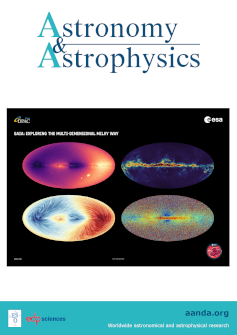Water vapour masers in long-period variable stars
IF 5.8
2区 物理与天体物理
Q1 ASTRONOMY & ASTROPHYSICS
引用次数: 0
Abstract
Context. We carry out decades-long single-dish monitoring of the variation in water-maser emission associated with the circumstellar envelopes (CSEs) of different types of evolved stars.Aims. We follow the variation in the maser emission over long time intervals (multiple optical periods) to understand the structure and kinematics of the stellar wind that drives the maser clouds away from the star. We also determine how this may depend on the stellar properties.Methods. We carried out monitoring campaigns with single-dish telescopes of water-maser emission at 22 GHz in the CSEs of four stars: o Cet, R Leo, χ Cyg, and R Cas. The observations took place with some interruptions between 1987 and 2023. The exact time interval differed from one star to the next, but no star was monitored for fewer than 15 years.Results. The variability in integrated flux in the masers in R Cas and o Cet followed the variability in the optical with the same period, but with a lag of about one-third in phase. R Leo was too often below our sensitivity threshold for us to determine a radio period. Remarkably, no maser at all was detected in χ Cyg. The variability in the masers in R Cas has a distinctive pattern. The total flux, modulated by the pulsations of the star, gradually increases to a maximum, which is followed by a similar decrease. This takes about 20 years. The pattern is repeated after an interval of quiescence of several years. Our observations have covered about one and a half cycle of this pattern so far. During its decline from a maximum, the variation in the flux resembles a damped harmonic oscillator. There are two dominant emission components that move almost tangentially on either side of the star with respect to the observer. The redshifted component likely originates from a single cloud and seems to be falling back towards the star. The blue component, moving in the CSE hemisphere nearest to us, has no drift in the line-of-sight velocity and appears to originate in a time series of short-living clouds with line-of-sight velocities within ~1 km s−1 of each other. No systematic velocity drifts are found in R Leo and o Cet. A few bursts of emission were detected at infrequent times in R Cas and R Leo that lasted about a year and caused an increase in the flux density by 1-2 orders of magnitude. The velocity range of the maser emission is ≲10 kms−1, which is narrower than the majority of the Miras and semi-regular variables we studied so far. In particular, in the stars with a low bolometric luminosity, o Cet and R Leo, only the brightest maser components from a limited part of the CSE are visible.Conclusions. The existence of a zone in the CSE with favourable conditions for maser excitation is confirmed most clearly in the case of R Cas through the unique pattern of its maser variability. The bolometric luminosity of a star and the velocity range of its water-maser emission, that is, the number of emission components in the spectra, are clearly correlated. Most maser components in the CSEs we studied originated in clouds that move almost perpendicular to the line of sight. The redshifted emission in R Cas is consistent with an origin in a single cloud that lived for at least about eight years.长周期变星中的水蒸气脉泽
上下文。我们进行了长达数十年的单碟监测与不同类型演化恒星的星周包层(cse)相关的水激微波发射的变化。我们在很长一段时间间隔(多个光学周期)内跟踪脉泽发射的变化,以了解驱使脉泽云远离恒星的恒星风的结构和运动学。我们还确定这如何取决于恒星的性质。我们利用单碟望远镜对4颗恒星的CSEs进行了22 GHz的水激微波发射监测活动:o Cet、R Leo、χ Cyg和R Cas。观测在1987年至2023年期间有一些中断。确切的时间间隔因恒星而异,但没有一颗恒星被监测的时间少于15年。在R - Cas和o - Cet中,微波激射器积分通量的变化跟随光学激射器的变化,但在相位上滞后约三分之一。R Leo经常低于我们的灵敏度阈值,我们无法确定一个无线电周期。值得注意的是,在χ Cyg中根本没有检测到脉泽。R - Cas中脉泽的变异性具有独特的模式。在恒星脉动的调节下,总通量逐渐增加到最大值,随后又出现类似的减少。这大约需要20年。这种模式在若干年的沉寂期后重复出现。到目前为止,我们的观察已经涵盖了这种模式的一个半周期。在从最大值下降的过程中,通量的变化类似于一个阻尼谐振子。有两个主要的发射成分,相对于观测者,它们几乎在恒星的两侧切线移动。红移的成分可能来自于一个单一的云,似乎正在向恒星回落。蓝色部分在离我们最近的CSE半球移动,在视距速度上没有漂移,似乎起源于视距速度在~1 km s−1以内的短寿命云的时间序列。在狮子座和狮子座没有发现系统的速度漂移。在R Cas和R Leo中,偶尔会发现一些持续约一年的发射爆发,导致通量密度增加了1-2个数量级。微波激射的发射速度范围为≤10 km−1,比我们目前研究的大多数Miras和半规则变量都要窄。特别地,在低热光度的恒星中,如狮子座和狮子座,只有来自CSE有限部分的最亮的脉泽分量是可见的。通过微波激射器变化的独特模式,最清楚地证实了CSE中存在有利于微波激射的区域。恒星的热光度与其水脉射发射的速度范围,即光谱中发射分量的数量,是明显相关的。我们所研究的CSEs中的大多数脉泽分量都来自于几乎垂直于视线移动的云层。R Cas的红移辐射与一个存在了至少8年的单一云的起源相一致。
本文章由计算机程序翻译,如有差异,请以英文原文为准。
求助全文
约1分钟内获得全文
求助全文
来源期刊

Astronomy & Astrophysics
地学天文-天文与天体物理
CiteScore
10.20
自引率
27.70%
发文量
2105
审稿时长
1-2 weeks
期刊介绍:
Astronomy & Astrophysics is an international Journal that publishes papers on all aspects of astronomy and astrophysics (theoretical, observational, and instrumental) independently of the techniques used to obtain the results.
 求助内容:
求助内容: 应助结果提醒方式:
应助结果提醒方式:


